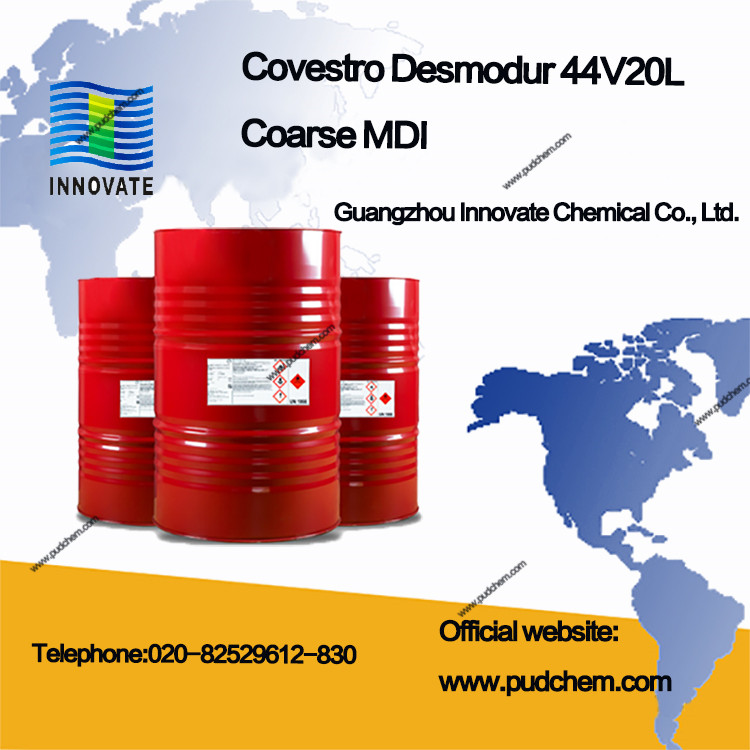Covestro Desmodur 44V20L Polymethylene polyisocyanate Coarse MDI black material Polymeric MDI

Product introduction
44V20 is a mixture containing a certain amount of higher functional isocyanate and diphenylmethane diisocyanate, and it is a dark brown liquid at room temperature.
Product Usage
44V20 can be widely used in the manufacture of polyurethane rigid foam insulation materials; it can also be used in isocyanurate foam, coatings, adhesives, anti-seepage plugging, structural foam, microcellular self-skin foam, automobile bumpers, interior decoration Parts, high resilience foam, synthetic wood and other fields. Due to its unique composition, it has good foam flow performance, and it is also used in the manufacture of products with strict requirements on the flowability of foaming liquid.
Physical and chemical properties
|
Property |
Value |
Method |
|
Exterior |
brown liquid |
Visually |
|
Viscosity at 25 °C |
160.0 - 240.0 |
MDI-01-02 |
|
NCO content |
30.50 - 32.50 %by wt. |
MDI-01-01 |
|
Density(25℃)g/cm |
1.220~1.250 |
GB 4472 |
|
Acidity (HCL) |
≤ 200 mg/kg |
MDI-01-03 |
|
Hydrolyzed chlorine (%) |
≤0.2 |
GB 12009.2 |
Packaging Specifications
250kg/drum
Storage (use) precautions
Due to the active chemical properties of 44V20, it is very easy to react with water to generate insoluble urea compounds and release carbon dioxide, causing bulging and increasing viscosity. Therefore, during the storage process, it is necessary to ensure that the container is strictly dry and sealed and filled with nitrogen for protection.
44V20 should be strictly sealed and stored in a well-ventilated room at room temperature (15℃~35℃); as the temperature decreases, the viscosity of 44V20 will increase, which will affect the use. If the storage temperature is too low (below 5 ℃), it can lead to crystallization, so it is necessary to pay attention to anti-freezing. Once crystallization occurs, the crystallization must be heated and melted in the shortest time; the heating of the material should not exceed 70 °C. Local overheating is strictly prohibited, as the product will decompose and generate gas at temperatures above 230°C. It is recommended to use a hot air oven equipped with a drum device for drying. After the drying is completed, the materials in the barrel must be mixed evenly. During the barrel drying process, the support points of the barrel should be paid close attention to prevent leakage due to wear and collision.
Long-term storage at 50°C should be avoided to avoid formation of insoluble solids and increase in viscosity.
Shelf life
The warranty period of 44V20 is 1 year from the date of delivery, provided that it is stored in accordance with the specified storage conditions.
Safety Precautions
44V20 has low toxicity in respiratory inhalation and skin absorption; low volatility makes it less toxic under normal conditions for short-term exposure (such as a small amount of leakage, scattering).
However, since 44V20 is an isocyanate-based compound, it still has certain toxicity, which can cause moderate eye irritation and slight skin irritation, which can cause skin allergies. The maximum allowable concentration (TLV) of 44V20 in air is 0.02ppm (0.2mg/m).
However, it must be noted that when the temperature of the material is heated to above 40 °C (such as melting) or in the working place, the concentration of suspended particles in the air will increase and cause poisoning. Respiratory masks and respirators should be worn when working in similar environments, or repeated inhalation of vapors exceeding the standard concentration will cause respiratory allergies.
Even under normal conditions, due to the active chemical properties of 44V20, care should be taken during operation to prevent direct contact with the skin and splashing into the eyes, immediately rinse with water, and wash the skin with soapy water. 44V20 is very easy to react with water to release carbon dioxide, so the packaging container should be dry and sealed to prevent water from pouring into it; once water leaks into the container, do not seal it too tightly, and should leave a vent hole to prevent it from bursting. .
More about this source textSource text required for additional translation information
Se
Fire and Explosion Hazards
MDI series products are listed as Class III Class B flammable liquids in the National Fire Protection Association (NFPA) Standard Manual; the so-called Class III Class B flammable substances refer to those substances with a flash point higher than 93.3°C; according to ASTM The flash point of MDI series products tested by D93 (P.M.C.C) method is 177~277℃.
Although the flash point is high, it is still flammable in the presence of oxygen and in the presence of high temperature and open fire; if the fire is strong, it can cause the airtight package to explode; hot materials can react strongly with water and release harmful gases.
- PREV:Germany Bruno Bock 2-EHMP 3-mercaptopropionic acid-2-ethylhexyl ester molecular weight regulator
- NEXT:Korea SK Coil coating application Saturated polyester resin (for topcoat) ES series index ES 450, ES 600, ES 812, ES 850





















